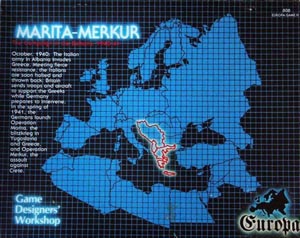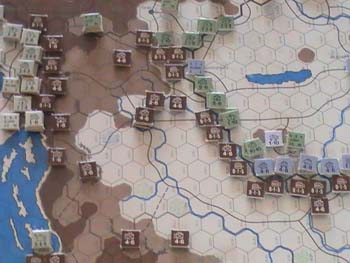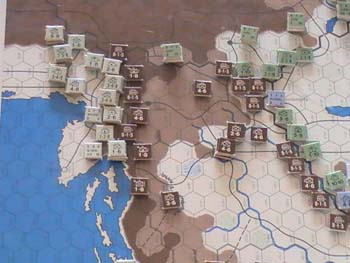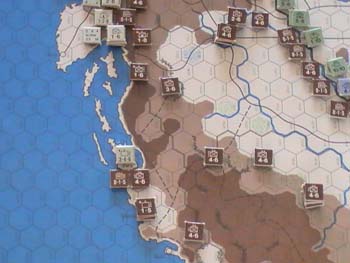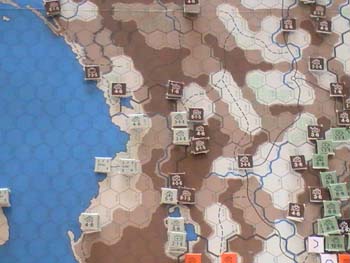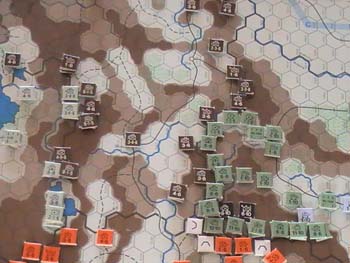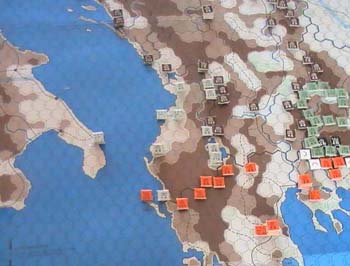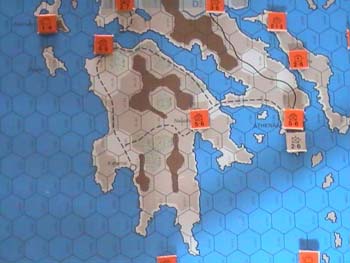A
detailed breakdown of the activities that may occur in a turn is presented below.
Activities inside each major heading are numbered and occur in the order shown;
those marked with asterisks may occur simultaneously. Numbers in parentheses refer
to appropriate rules sections. At
the start of each game turn
1. Weather determination (28)
2. British
evacuation decision (27.E)
3. British interdiction decision (31.L)
4. German
intervention deployment (31.E.2)
If German intervention has been triggered
(on good weather roll):
German Special Invasion Turn (prior and in addition
to German phasing player's turn)
Movement Phase: Yugoslav units checked for
defection (Rule 31,G)
Exclude Exploitation Phase
Only German units
may operate, other Axis forces may not
Yugoslav air units may not fly patrol
attacks or interception
When all Yugoslav supply sources is Axis controlled
simultaneously the Yugoslav army ceases operations (Rule 31, H)
At the
start of each player turn 1. Phasing aircraft repair (24) Main
Sequence:
Supply Determination Phase
1. Check supply
status of all units (12)
2. Check for Greek Collapse (31.1; Axis supply determination
phase
only): After German Intervention, every unit that cannot trace a supply surrenders
(remove from map) (Rule 31, G) Movement
Phase
The phasing player (Axis player in his player turn; the Allied
player in his) may move any or all of his units in accordance with the provision
of Rule 5 - Movement
1. Receive reinforcements (32)
2. Break down units
(16.A)
3. * Move units (5)
4. * Execute overruns (13)
5. * Use engineering
abilities (14.A)
6. * Use naval transport 127)
7. Reassemble broken down
units (16.A)
8. Upgrade Greek units (32.D) Air
Phase
Players may deploy their air units and conduct air combat in
accordance with the air rules (see Rule 22)
Movement segment
1. Return air
units from shipping bombing (21.E.6)
2. Return air units from defensive air
support (21.E.7)
3. Phasing player repairs ports (21.E.8)
4. * Phasing
air unit movement (19)
5. * Resolve patrol attacks (20)
6. Enemy interceptor
movement (21.A)
Air combat
7. Use German naval transport (31.M)
8. Air
combat preparation (22.A)
9. Air combat resolution (22.8)
10. * Target
defense and attack (22.C)
11. * Jump paratroops (21.D,3, 25.A1)
12. *
Resolve paratroops attacks (26)
13. * Resolve special naval assaults (31.M)
Return
segment
14. Phasing air unit return (19)
15. Enemy interceptor return (19) Ground
Combat Phase
The
phasing player resolves all attacks he decides to make in accordance with the
combat rules
1. Resolve combat (8)
2. Conduct retreats (8.F.1)
3. Perform
advances (8.F.2) Exploitation
Phase
The phasing player may move (again) any or all of his units that
are listed as combat motorized on the Unit Identification Chart
1. Break down
combat/motorized (C/M) units (16.A)
2. * Move C/M units (5)
3. *Execute
overruns (13)
4. * Use C/M engineers abilities (14.A)
5. Reassemble broken
down C/M units (16.A) At
the end of each player turn
Check for Yugoslav collapse (31.H) At
the end of each game turn
1. Tally victory points (34.B)
2. Check
for Yugoslav coup (31.D)
3. Check for German assistance/intervention (31.E.2).
German intervention cannot occur until the first clear weather turn after intervention
has been triggered.
4. German withdrawal decision (Rule 34.C.1). Special
Events
Special invasion turn (31.F): Prior to the Axis player turn
on the turn of German intervention. Yugoslav
Defection (31.G): At the end of the movement phase of the special invasion turn. German
motor boat entry (31.M.1): Anytime. German
capture of shipping (31.M.2): When Athenai falls. Rhodes
special activities (31.N): Anytime after the first British evacuation. Operation
Marita: (the invasion of Greece and Yugoslavia) 6 April 1941 Operation
Merkur: (the airborne invasion of Crete) 20 May 1941 | 